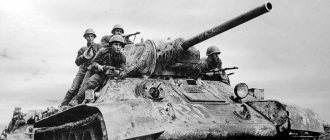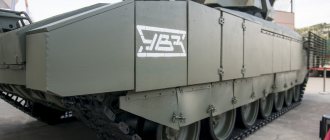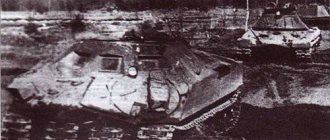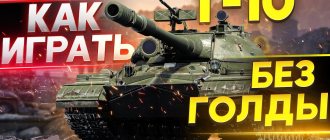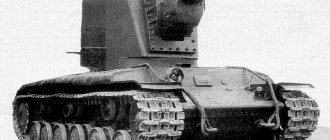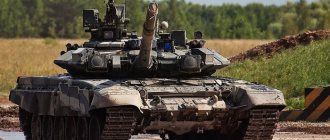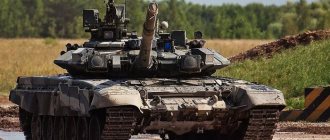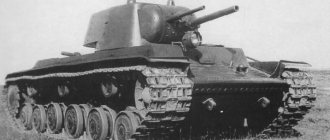“I look after her: there is nothing in her, but I keep looking, I don’t take my eyes off...” These lines of a famous Soviet song of the last century seem to tell about the new self-propelled gun IX K-91-PT. The combat vehicle was also developed in the USSR - and, at first glance, there is nothing special about it.
The accuracy is 0.4, the armor penetration of shells is like that of a heavy tank, and this vehicle can boast of armor only in the control room. Then why is it worth spending 12 tokens on it? Let's figure it out!
Firepower
The K-91-PT is equipped with a 122 mm S-34-49 gun. In terms of its characteristics, it is more reminiscent of a heavy tank cannon: accuracy - 0.4, aiming time - 2.60. All this suggests that standing in the bushes and targeting enemy vehicles at a distance will turn out poorly. What then remains? Storm!
The K-91-PT was created precisely for this. The gun reload time can be increased to just over six seconds, depending on the skills of the crew and the type of equipment. This will allow you to inflict significant losses on enemy vehicles, especially heavy tanks - one of their shots can be answered with two, which are likely to cause damage. The armor penetration of basic and sub-caliber self-propelled shells is good!
The average damage per shot of the K-91-PT is 390 units, which is quite a lot at such a reload speed. The damage per minute on this tank destroyer can easily be increased to almost 3500 units .
Equipment selection
The set is classic, but taking into account the level of battles, we recommend installing improved consumables:
- First aid kit.
- Repair kit.
- Fire extinguisher.
you can develop your sniper playing skills with an additional ration . All tank indicators will increase, but do not forget about the consumption of silver coins, since these “goodies” cost a lot and will require constant replenishment before going into battle.
Booking
The body of the K-91-PT is poorly protected: the 120 mm thick forehead is relatively easily penetrated by Tier VIII and higher vehicles. It is better to hide it behind folds of terrain or obstacles.
But it will not be easy to penetrate the front of a 260 mm thick cabin, especially if you do not use sub-caliber or cumulative shells. The armor given here can reach up to 340 mm. Not every weapon can cope with this; it will be especially difficult for the “eights”.
The machine gun located on the side of the gun is not a weak point, so there is no need to hide it.
Selection of equipment for K-91
An economical option, if you do not add additional rations and you have a new crew, and the commander does not have all the perks to review, then taking into account the gameplay of this vehicle, we recommend taking a closer look at this assembly:
- Coated optics.
- Rammer.
- Vertical stabilizer.
Thanks to optics, we added 41 meters to the basic overview.
If everything is fine with the review, you should use the universal option:
- Improved ventilation.
- Rammer.
- Vertical stabilizer.
If you feel a lack of dynamics, you can replace the ventilation with a Turbocharger.
The “sniper assembly” also has a right to exist due to increased accuracy:
- Rammer.
- Vertical stabilizer
- Improved sight.
Below you can look at the difference in performance characteristics with different equipment options:
How to play?
- The K-91-PT performs best in close and medium range combat. Don't stand in the bushes - you won't be able to realize all the excellent DPM of this machine, and the relatively low accuracy will contribute to frequent misses.
- At the beginning of the battle, try to take a position that will allow you to deal damage to slower opponents who are still on the march.
- Remember about small gun declination angles.
- Do not expose your hull to enemy guns - this is the right path to the Hangar.
- If there is a heavy tank in front of you and it takes more than 10 seconds to reload the gun, then wait for it to fire, positioning the wheelhouse, and then feel free to drive out and shoot twice yourself.
- At medium distances, work from camouflage. On the K-91-PT it is quite high, and if you illuminate an enemy tank, then drive away from the bush so that it becomes opaque and shoot, the tank destroyer will not illuminate.
- Keep an eye on the mini-map. Speed allows you to quickly respond to the situation. It is always better to enter the flank of an enemy who has taken a convenient position than to shoot head-on.
So is it worth spending 12 tokens on this self-propelled gun? Definitely yes! The K-91-PT is capable of bringing a lot of fun and features vigorous tank gameplay. You can also use it to train crews for other Soviet vehicles and enjoy the game! And it’s better to do this right now if you have the required number of tokens!
Does Poland know how to use tanks?
Having escaped from the tutelage of their “big brother” in the face of the dying USSR in 1989, the Poles remembered their once serious military-political ambitions. In the minds of some of the Polish intelligentsia, the country was seen as at least a new regional superpower, which the equipment of the army had to correspond to. Polish designers began designing the most modern weapons - new generation aircraft, attack and transport helicopters, and new air defense systems. Much attention was paid to armored vehicles.
Along the Soviet path
At the end of the 1980s, the direction of development of Polish armored vehicles was simple and clear: until 1991 it was planned to continue production of the T-72M1 tank under license, although it was obvious that it was outdated for modern combat. The Polish leadership saw two options for solving the problem. Firstly, in 1987, negotiations began with the USSR on the acquisition of a trial batch of T-72S tanks (export modification of the T-72B) and a license for their production. This option was considered the most likely, including from Moscow.
PT-91 Twardy with ERAWA dynamic protection complex
In addition, it was decided to begin independent research into the possibilities of modernizing T-72 tanks based on the experience gained during the development of the T-55AM Merida. It was assumed that the obtained developments would be used to improve the T-72S tanks during their mass production. Engineers (Bumar-Łabędy) and designers from OBRUM (Ośrodek Badawczo-Rozwojowy Urządzeń Mechanicznych - Mechanical Equipment Research Center) were involved in the work.
The situation changed dramatically in 1989. Due to the change of power in Poland and the revision of the Soviet policy of supporting former allies in Eastern Europe, problems arose with obtaining a license for the T-72S. The Soviet Union raised the price and demanded a ban on the export of Polish tanks and changes to the project without the involvement of Soviet designers. Such conditions did not suit the new Polish leadership, so all negotiations with the USSR were stopped.
It became clear that Poland would have to modernize the tanks on its own. Also in 1989, work began on the Wilk (“Wolf”) program, which involved the creation of a modification of the T-72M using Polish components. The list of new products included a new ERAWA dynamic protection kit made in Poland, a new fire control system with a Polish laser rangefinder and a second-generation thermal imager, a new gun stabilization system and a more powerful engine.
PT-91 Twardy with ERAWA-2 dynamic protection complex
In general, work on the program was successful, and in 1990 the Polish industry decided to try its hand at a more complex project. The new PT-91 Twardy (“Twardy” - hard, harsh) was a deeper modernization of the T-72M1 tank. One of the main tasks was not only to improve its own tank fleet, but also to lay the basis for the unification of armored vehicles with Western standards, which Poland was now focusing on. We can talk for a long time about the history of the T-72M2 Wilk and PT-91 Twardy, but they are not the topic of the current article, and those interested can easily find the information they need.
Future plans
In parallel with the start of work on the PT-91, the understanding came that no matter how you modernize the T-72, it would not become a full-fledged modern tank. In addition, in the mid-1990s, fourth-generation tanks were expected to appear in the arsenal of Western countries and the USSR, which became the most likely enemy, for which even the PT-91 would not pose any threat. OBRUM began work to solve the “tank problem of the Polish Army”, and in three directions at once.
The first option again involved a deep modernization of tanks based on the T-72. The Poles hoped to receive new technologies from the West and with their help to seriously improve the machines already mastered in mass production. The second direction involved the development of our own third-generation tank, not inferior to the best existing examples of Western and Soviet tank building. Finally, the third path involved starting work on a full-fledged fourth-generation Polish tank. We will talk about these three areas.
Work on a program for further modernization of T-72 tanks began during the design of the PT-91 in 1991 - the tank modernization plan was developed before 2005. In 1993, it was planned to begin serial production of the PT-91 itself, but due to a number of problems in the Polish industry, it went into production with flaws. Thus, it was not possible to develop the new gun stabilizer in due time, which subsequently prevented the installation of guns of higher power. In parallel with the debugging of serial production of the PT-91, work was to begin on the export version of the PT-91M. It was supposed to use Western-made components as widely as possible without making major changes to the design of the tank. The Poles expected to find interest in this modification from states that had left the communist bloc and were looking for an opportunity to modernize their armed forces. The problems of the PT-91 series were supposed to be solved only with the PT-91B modification, which was planned for release in 1995. By that time, the stabilizer, the ERAWA-2 dynamic protection kit and the guided weapons system should have been finalized.
Main new elements of the RT-94 tank
The next stage in the development of the Polish T-72 was supposed to be the RT-94 with the massive introduction of Western electronics. So, he was supposed to receive a digital fire control system with thermal imagers from the commander and gunner. Other innovations were expected to include a digital communication system and the installation of an on-board computer system to simplify vehicle diagnostics and crew training. The tank's mobility would also be improved due to the use of a 1000 hp engine, a new suspension and an auxiliary power unit that ensures the operation of the tank's electronic systems without starting the main engine. In addition, it was on the basis of the RT-94 that it was planned to develop experimental vehicles to test solutions for more serious projects.
The final stage in the development of this line was to be the RT-97 tank, work on which was planned to begin in 1997 and put into mass production in 2000. The project completely changed the design of the frontal part of the hull - it was supposed to get rid of the weakened zones characteristic of the entire T-72 series, and seriously increase the thickness of the armor by adding additional sheets of composite armor. The goal was to provide protection against the most common 125 mm Soviet shells. The tower was also replaced with a new, welded one. During its development, cooperation with German companies was assumed to provide protection at the level of the Leopard 2A4 tank and the integration of a new generation of dynamic protection into the design.
RT-97 tank project
The old Soviet 125-mm gun was replaced either with a new one of the same caliber, developed in Poland, or with a 120-mm gun, unified in ammunition with NATO standards. It also included the installation of a 12.7 mm remote-controlled machine gun and a 60 mm turret mortar, a new hydraulic suspension and a new 1200 hp engine. In general, in the form of the RT-97 tank, the Polish military hoped to receive a vehicle that was in no way inferior to the best Soviet models of the early 1990s and capable of remaining a good second-line tank after the appearance of fourth-generation vehicles.
Fighting Polish gorilla
As part of the second path of development of Polish armored vehicles, in 1990 OBRUM began proactive work on a tank project under the unofficial name Goryl (“Gorilla”). Initially, two options were studied, both with a traditional layout: the first with a 120-mm smoothbore gun of the Rheinmetall Rh-120 type and a mechanized ammunition rack in the rear niche of the turret, and the second with a 125-mm gun and an automatic loading system of the T-72 type in the fighting compartment. After additional research, preference was given to the first option as it ensures greater survivability of the tank on the battlefield.
In 1992, the development of the project was completed. Despite the disappearance of the immediate threat from the USSR, Polish engineers saw potential in the Gorilla both for use in the Polish army and for export. The design of the tank was in many ways reminiscent of the French Leclerc. The welded hull had a sloping frontal part made of multi-layer armor equivalent to approximately 750 mm of steel. The driver was located on the left, while on the right, as on the Leclerc, there was an additional mechanized ammunition rack.
Model of the promising Goryl tank
The welded turret also had multi-layer frontal armor with the equivalent of 850 mm of steel. There were two crew members in the turret, behind them in the aft niche there was a conveyor-type automatic loading system. The ammunition rack was separated from the fighting compartment by an armored partition and equipped with ejection panels modeled on Western tanks. Additional protection for the tank was provided by side screens with NERA (Non-Energetic Reactive Armor) type protection. The option of installing a new generation of active dynamic protection on the forehead of the hull and side screens was considered.
The tank was supposed to be powered by a Rolls-Royce Condor engine with a power of 1,500 hp. The hydropneumatic suspension ensured the vehicle a smooth ride at any speed, simplifying the operation of the stabilization systems. The fire control system included a stabilized panoramic commander's observation device with integration of a night vision device and a thermal imager, a gunner's sight with a thermal imager, and a computer ballistic computer with a set of external sensors. The main armament of the Gorilla is a Polish-developed 120-mm smoothbore gun stabilized in two planes, capable of firing the main types of NATO ammunition and guided missiles.
Approximate internal structure of a Goryl tank
As an option for export, it was possible to install a 125 mm Polish-made gun. Additional armament included a 7.62 mm machine gun coaxial with the cannon and one or two remote-controlled 12.7 mm machine guns on the turret. The option of placing a 60-mm mortar in the turret or replacing one of the machine guns with a small-caliber automatic cannon was studied. In addition, the tank was to receive a satellite navigation system and on-board computers for all crew members. In the future, the vehicle could be integrated into an electronic battlefield system.
Based on the Gorilla, it was planned to develop a whole series of combat and auxiliary vehicles. These included an anti-aircraft missile and anti-aircraft artillery system, a command and staff vehicle, a heavy infantry fighting vehicle, a tank bridge-laying vehicle, an engineering tank and an armored vehicle. By 1994, the tank project was completed and presented both to the Polish military and at a number of exhibitions. At the same time, the military proposed to abandon the silent name “Gorilla” and rename the tank in honor of General Vladislav Anders. It is unknown whether this decision was approved, but the name Anders appears in further correspondence. I would also like to note that on the Internet it is common to use the RT-94 index in relation to “Gorilla”/“Anders”, which is incorrect.
Vehicles based on the Gorilla/Anders tank
By 1995, the military approved the project, but it did not receive further development - the Polish military's expectations of receiving an increased military budget were not met. If in 1990 the Poles had hope for serious subsidies from the West as the front line of defense against the USSR, then after the collapse of the Soviets they no longer had to count on them. The appearance of the CIS countries on the arms market also brought down Polish export plans: the Russian Federation and Ukraine occupied exactly the niche that the Poles were targeting, while offering much more advanced vehicles at more attractive prices. As a result, both the plans for the RT-94/97 and the Gorilla/Anders had to be temporarily abandoned.
“Leopard” or “leopardization”?
Interest in new tanks reappeared in 1998, against the backdrop of the final decision to admit Poland to NATO. This created problems for the Polish military - the unification of their weapons with Western ones was insufficient. The question also arose about tank forces. A simple re-equipment of the T-72 family tanks with Western 120-mm guns was impossible due to serious differences in shells and the inability to adapt a Soviet-type automatic loader to Western shots. It was decided to purchase Leopards from neighboring Germany or develop a project for the deep modernization of T-72M/RT-91 tanks.
Polish industry and the military strongly opposed the first option, pointing out that the Germans were offering obsolete Leopard 2A4 tanks for sale, asking exorbitant prices for new modifications. In addition, the decision would deal a serious blow to Polish industry, leaving it without important orders. Therefore, again, under the RT-2000 index, the “Gorilla” / “Anders” project was proposed for development and work began on modernizing the RT-91 under the RT-2001 index. This project was supposed to take advantage of the advantages of the Soviet tank design in the form of light weight and small overall dimensions, together with Western weapons and enhanced armor protection.
Project PT-2001 Gepard, a variant of deep modernization of the RT-91 tank
The RT-2001 was developed in cooperation with French specialists, therefore one can find in it features of GIAT’s projects for the modernization of the T-72. It was proposed to replace the turret of old tanks with a new welded one with a mechanized ammunition rack in the rear niche. For armament, either the Ukrainian-Polish 120-mm KBM2 gun or the French CN120-26/52 was proposed. Additional weapons were similar to those available on production RT-91s - a coaxial rifle-caliber machine gun and a large-caliber turret machine gun. The fire control system was also supposed to be made in France. The turret and hull were additionally reinforced with explosive reactive armor units—the option of installing a Ukrainian or Israeli-made complex was considered.
On the other hand, OBRUM pointed out that even with such modernization, the future RT-2001 will seriously lose to competitors both in the west and in the east. Based on this, they proposed instead of the RT-2001 the development of their RT-2000. Quite a lot distinguished the new RT-2001 from the previous “Gorilla”. In order to reduce the size and weight, the turret was redesigned, maintaining a similar level of armor protection; in order to reduce the cost, they abandoned the complex hydropneumatic suspension, retaining the Soviet six rollers on board and torsion bars. To assemble the hull, they provided for the possibility of using converted hulls from the T-72, although the number of changes made this not very profitable. Nevertheless, the unification of many parts with the RT-91 was retained.
Project PT-2001 Gepard, a variant of a new tank from OBRUM while maintaining continuity with the PT-91
In 2001, both the T-72 modernization project and the new tank project from OBRUM were studied by the military. The choice was made in favor of the first option, cheaper and less risky. The final decision was made by politicians, not the military - the modernization of old tanks was recognized as meaningless, and for the sake of “strengthening partnership and unification” it was decided to purchase German Leopards 2A4 with further local modernization. Although this decision caused serious criticism in the Polish armed forces, nothing could be done.
At the forefront of progress
Let's go back to the early 1990s. Despite the fact that work on a fourth-generation Polish tank was envisaged back in 1990, there was no particular progress. The situation changed in the middle of the decade after establishing cooperation with Ukrainian tank builders. The information received about the Hammer and Note projects, as well as news about work in the Russian Federation on the Object 640 and Object 195 tanks again set Polish design thought in motion.
Polish tank of the fourth generation with a six-wheel chassis developed in 1997
Based on an analysis of information on both Soviet developments and data on promising Western vehicles, the design of a two-seat tank with an uninhabited turret was chosen as the main option. In addition, to protect the crew, it was decided to use a front-engine layout. Another measure to enhance the survivability of the tank was to move all the ammunition to the rear of the tank with external supply of shells to the turret. Similar solutions were used in early Leclerc projects; it is difficult to say whether the Poles borrowed them from the French or designed them themselves.
The ammunition rack was separated from the crew by an armored partition and equipped with ejection panels. The tank's armor was multi-layered and combined, capable of withstanding any 125-mm projectile; provision was made for the installation of dynamic protection and an active protection complex of Polish-Ukrainian design. The main armament is a 125-mm or 140-mm cannon; to develop the latter, it was planned to establish cooperation with Germany or Ukraine.
Polish tank of the fourth generation with a seven-roller chassis developed in 1997
An interesting solution was that both crew members had all the controls of the tank and could serve as a driver and commander-gunner. According to the developers, this allowed the tank to remain combat-ready if one of the tankers failed. Observation of the battlefield was carried out using cameras on the body and on retractable rods. The tank was powered by a German diesel MTU MT-881 with a power of 1090 hp. Initially, the tank was developed on a six-wheel chassis with hydropneumatic suspension, but later it was decided to replace it with a seven-wheel one for better ride smoothness and load distribution. Work on the project was carried out until 1999 and did not involve the construction of even an experimental machine of this type. Rather, these were tests and searches for solutions for the future fourth generation Polish tank.
The Poles returned to the topic of a new generation tank in the mid-2000s. Against the backdrop of growing cooperation with Rheinmetall to create a Polish modification of the Leopard 2A4, the idea was born to create a joint venture that could build a fourth generation tank for Poland and for export. Even a preliminary design of this tank was developed: in general, its layout solutions were less revolutionary than those of the 1997 project. The crew again grew to three people, the engine returned to the stern, and the ammunition rack was located in the fighting compartment.
Polish tank of the fourth generation developed in 2003
An interesting solution was the use of a carousel-type automatic loader, which is uncharacteristic of Western tank building. An additional mechanized ammunition rack was located in the aft niche of the uninhabited turret. Unfortunately, there is no other information about the project. Apparently, work on it has not left the idea stage. It also didn’t work out with possible cooperation with the Germans - the Polish leadership simply decided to purchase more modern German Leopards 2A5.
Places for the elderly
In addition to the problem of weapon unification, in the early 2000s another issue arose in Poland - more than 800 T-55A and T-55AM tanks remained at storage bases, which the Poles were not ready to cut into metal. However, if the T-72M1 and especially the RT-91 still had a chance of successful use, the T-55 was outdated even for local conflicts. It was intended to use their chassis for various projects of auxiliary equipment, but the most interesting is the project of the heavy armored personnel carrier Odyniec (“Odynets” - wild boar, lone boar), developed in 2001.
Project of the Odyniec heavy armored personnel carrier based on the T-55 tank
“Odynets” largely repeated the solutions of the Israeli Akhzarit vehicle and the Russian BTR-T. In place of the fighting compartment, it was planned to place a landing compartment for eight people, in the front of the vehicle - a driver and commander shifted to the left, operating a small turret with a large-caliber machine gun and an automatic grenade launcher. As a result, the Polish army could receive an armored personnel carrier protected from fire from 100-mm and 105-mm cannons, but the project did not arouse interest among the military, mainly due to lack of funding and undeveloped deployment of troops.
It cannot be said that the listed developments at the turn of the century ended in nothing for Polish tank building. Although grandiose plans to promote Poland into the leading tank-building powers could not be realized, and the purchase of Leopards had a negative impact on Polish industry, the fuse still remains. Thus, the Poles retain hope of seriously improving the old RT-91: the RT-16 and RT-17, two new modernization options, were recently shown. Polish industry has also mastered the production of wheeled armored personnel carriers/infantry fighting vehicles Rosomak (“Wolverine”), and a promising new generation infantry fighting vehicle is being developed. Time will tell whether Poland will be able to strengthen its position in the global tank building industry.
Literature:
- Andrzej Dominik. Goryl ogniwo – triady dynamic znej obrony RP. Czy Loara, Goryl i Huzar będą bronić Polski? / Report WTO – 4/1998 – p.11-14
- Jerzy Kajetanowicz. Czołg podstawowy PT-91 Twardy / Poligon – 3/2013 – p.4-23
- Tomasz Szulc. Moderna kontra Twardy / Nowa Technika Wojskowa – 3/1995
- https://militarium.net
- https://otvaga2004.mybb.ru
Results
The tank is quite unique, but has an excellent weapon, for which it is considered the main competitor of the German ST Leopard 1. You need to start leveling up only after gaining experience in battles, otherwise the tank will not bring the expected emotions from the game. Due to the rear location of the turret and the specific gameplay, the technique is skill-dependent. In the right hands, in 5 minutes of battle you can shoot a tidy sum of units of damage and remain unharmed; turbo battles with such a rate of fire are not scary.

